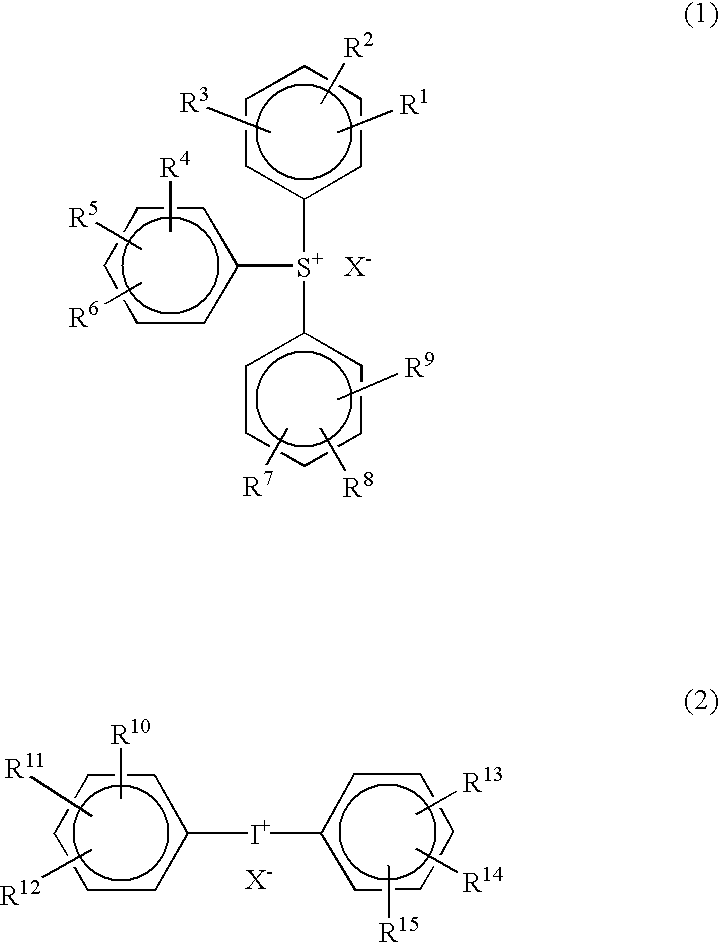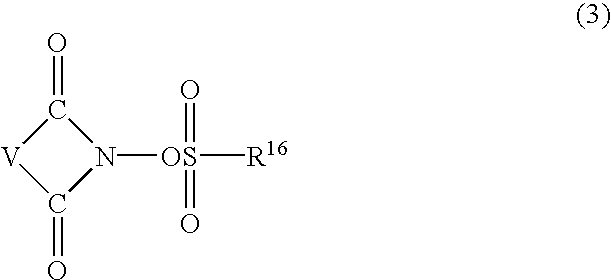Negative type radiation sensitive resin composition
a radiation sensitive resin and negative-type technology, applied in the field of lithography, can solve the problems of reducing the resolution and making the top portion of the pattern not rectangular but round, reducing the dissolution speed in the developer of the exposed portion, and difficult to form a satisfactory fine pattern
- Summary
- Abstract
- Description
- Claims
- Application Information
AI Technical Summary
Benefits of technology
Problems solved by technology
Method used
Image
Examples
synthetic example 1
[0174] 100 g of p-t-butoxystyrene, 10 g of styrene and 9.0 g of azobisisobutyronitrile were dissolved in propylene glycol monomethyl ether to carry out a polymerization reaction at 80.degree. C. for 9 hours. The polymerization solution was purified by re-precipitation with methanol to obtain 100 g of a copolymer of p-t-butoxystyrene / styrene having an Mw of 7,300 and an Mw / Mn of 1.80. This copolymer and 50 g of 10 wt % sulfuric acid water were dissolved in 300 g of propylene glycol monomethyl ether to carry out an acid hydrolytic reaction at 90.degree. C. for 6 hours. The reaction solution was purified by re-precipitation with a large amount of water until it became neutral to obtain 65 g of a copolymer of p-hydroxystyrene / styrene (molar ratio of 85 / 15) having an Mw of 5,500 and an Mw / Mn of 1.55 (A-1).
synthetic example 2
[0175] The procedure of Synthetic Example 1 was repeated except that 20 g of styrene and 10 g of azobisisobutyronitrile were used to obtain 70 g of a copolymer of p-hydroxystyrene / styrene (molar ratio of 75 / 25) having an Mw of 5,200 and an Mw / Mn of 1.51 (A-2).
synthetic example 3
[0176] Polymerization and acid hydrolysis were carried out in the same manner as in Synthetic Example 1 except that 20 g of p-methoxystyrene was used in place of styrene to obtain 78 g of a copolymer of p-hydroxystyrene / p-methoxystyrene (molar ratio of 80 / 20) having an Mw of 5,900 and an Mw / Mn of 1.58 (A-3).
[0177] Alkali-Soluble Resins (A)
[0178] (A-1): copolymer of p-hydroxystyrene / styrene (molar ratio=85 / 15, Mw: 5,500, Mw / Mn: 1.55)
[0179] (A-2): copolymer of p-hydroxystyrene / styrene (molar ratio=75 / 25, Mw: 5,200, Mw / Mn: 1.51)
[0180] (A-3): copolymer of p-hydroxystyrene / p-methoxystyrene (molar ratio=80 / 20, Mw: 5,900, Mw / Mn: 1.58)
[0181] (A-4): copolymer of p-hydroxystyrene / styrene (molar ratio=84 / 16, Mw: 5,200, Mw / Mn: 1.12), VPS5015 of Nippon Soda Co., Ltd.
[0182] (A-5): copolymer of p-hydroxystyrene / styrene (molar ratio=78 / 22, Mw: 3,100, Mw / Mn: 1.13), VPS3020 of Nippon Soda Co., Ltd.
[0183] (A-6): copolymer of p-hydroxystyrene / styrene (molar ratio=84 / 16, Mw: 3,000, Mw / Mn: 1.13), VPS3015...
PUM
| Property | Measurement | Unit |
|---|---|---|
| dissolution speed | aaaaa | aaaaa |
| width | aaaaa | aaaaa |
| wavelength | aaaaa | aaaaa |
Abstract
Description
Claims
Application Information
 Login to View More
Login to View More - R&D
- Intellectual Property
- Life Sciences
- Materials
- Tech Scout
- Unparalleled Data Quality
- Higher Quality Content
- 60% Fewer Hallucinations
Browse by: Latest US Patents, China's latest patents, Technical Efficacy Thesaurus, Application Domain, Technology Topic, Popular Technical Reports.
© 2025 PatSnap. All rights reserved.Legal|Privacy policy|Modern Slavery Act Transparency Statement|Sitemap|About US| Contact US: help@patsnap.com



